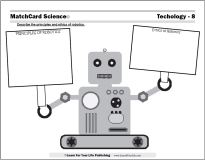Chemistry Games
Build Carbon, Nitrogen and Oxygen Atoms with our MatchCard Chemistry Game
Chemistry Games are from the MatchCard Science Chemistry Unit Study for grades 3 - 8. Students continue to learn about atoms and molecules.
Free Download Below


MatchCard Science Chemistry Games Worksheet
Objective: Give the chemical symbol, atomic number, and electron configuration for the following elements: carbon, nitrogen, oxygen.MatchCard: Download below.
Students can use the MatchCard Information Pieces to match names, atomic numbers, and chemical symbols of these common elements:
- Carbon
- Nitrogen
- Oxygen.
Download and Use the Chemistry MatchCard


This is MatchCard #3 of the Chemistry Unit Study. Find more information on MatchCard Science below.
Quick Chemistry Review
This third lesson requires students to know the following information which can easily be reviewed with the Chemistry MatchCards:- Model of atoms including parts of atoms and where they are located.
- Atomic number differentiates one atom from another.
Paper Plate Atomic Models
Students have also constructed simple models of atoms using paper plates. Little pieces of paper marked with "P" for protons and "E" for electrons are placed either in the nucleus or the electron shells outside the atom.Students have also learned that every chemical has its own name, chemical symbol, and atomic number - which is the number of protons in the nucleus.
Learn More With MatchCard 3
With this third MatchCard, we are going to learn the following information about atoms:- State the atomic number and chemical symbol of carbon, nitrogen, and oxygen.
- Demonstrate that electrons fill the electron shells from inside to outside.
- Pair electrons in the electron shells when possible.
- Discover that chemistry is fun.

Playing MatchCard Chemistry
Each student will either need their own copy of Chemistry MatchCard 3, or three paper plate atomic models.You will also need either the small papers with "P" and "N" (paper from a hole punch works well) or coins to represent electrons and neutrons.
You will also need a single die (that's one dice - one die is grammarically correct but still sounds strange.)
And, finally, each student needs their own copy of the MatchCard Information pieces. You will want to mix these up so they aren't in order and have them in a stack.
How to Play the Chemistry Games
The first player takes one of the information pieces. It will be either a chemical name, symbol, or atomic number of one of the three types of atoms. They have to put it with the correct model.If they correctly match their information piece, they can roll the die. Whatever number they get, they must take that number of electrons OR protons, and begin to build any of the three models.
They cannot split the number. For instance, if they roll a five, they cannot take three protons and two neutrons. They must take five OR LESS of either protons or neutrons.
At the end of this play, it is the next players turn.
When placing electrons, they must fill an inner shell before moving to the next shell.
Single electrons will be placed in a shell before pairing the next electrons.
The winner is the first person to build all three models.
Reviewing with the Chemistry Games MatchCard
Kids like playing games with others, but with this and every other MatchCard, students can have a game-like review of all science concepts. While they would not have to build the model each time, students can continue to differentiate the three types of atoms they have learned: carbon, nitrogen, and oxygen.More Advanced Chemistry Games
With out next MatchCard, their knowledge will grow as they learn the elements sodium, chlorine, and aluminum and start to fill the third electron shell.MatchCard Science
How To Use MatchCards

Download the FREE MatchCard Science Instructor's Guide and see how MatchCards can make building their science knowledge base fun.
Chemistry Unit Study

Explore the building blocks of matter with the chemistry unit study.
12 Science Unit Studies

Chemistry is only one of twelve complete unit studies for kids in 3rd to 8th grade.
Comprehensive objectives, hands-on projects, suggested science fair experiments, and the fun game-like MatchCards keep them interested in learning science. See all twelve MatchCard Science Unit Studies.
About Our Site
Hands-On Learning













